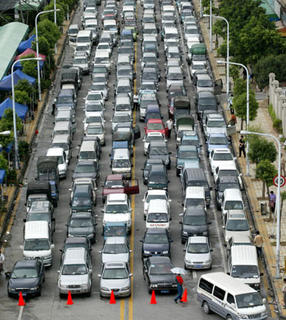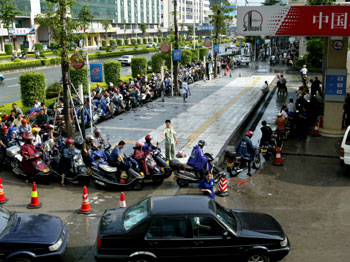 Click this link to look at the chart at EIA. Notice the pikes since 2004
Click this link to look at the chart at EIA. Notice the pikes since 2004- 67) OPEC delegates agree to lower the cartelÂ’s output ceiling by 1 million barrels per day, to 23.5 million barrels per day, effective April 2004.
- 68) OPEC agrees to raise its crude oil production target by 500,000 barrels (2% of current OPEC production) by August 1—in an effort to moderate high crude oil prices. Price onlfellened slightly but quickly shoot up (compare the quantitative adjustment of 68 with 67)
- 69) Hurricane Ivan causes lasting damage to the energy infrastructure in the Gulf of Mexico and interrupts oil and natural gas supplies to the United States. U.S. Secretary of Energy Spencer Abraham agrees to release 1.7 million barrels of oil in the form of a loan from the Strategic Petroleum Reserve. Price corrected briefly and shoot back right afterward
- 70) Aug/1/2005: King Fahd died, although Saudi has been effectively ruled byt he heir for about 10 years already, oil price continued to hike with this excuse
- 71) Aug/27/2005: Hurricane Katrina send oil price to $69, do we expect oil price to correct when production resumes in Gulf of Mexico?
You can see every single time when there is an event favorable for oil price to rise, it rises. Even if that temporal event has ceded, the price does not correct to its original value, as it should have (because it is unlikely the demand/supply scenario changed that much during a couple weeks). However, when there is an event indicating the other way, oil price did not adjust to the same scale. What am I getting at?
- There is a fundamental trend of continuous rise in demand, no question about it, China and India, 2.3 bn people consuming oil. However, this rate of increase is not new in 2004. We had it coming since 1998, or may I say 1978?
- The pikes seems to be pushing beyond a normal upward trendline (which can be plotted using x-day average), So it is very likely that someone is trying to manipulate the market (on top of reason 1 above), the speculators, the hedge funds
These are no news to any of us. After all, speculators are riding the general market expectation, and very often, helping market close in to the "equilibrium price". However, when we study the one-sided adjustments above, it is hard not to believe that oil price has already passed the "equilibrium point". Dong Tao of CSFB seems to agree. He said that "hedge fund are responsible for today's high oil price". (Via 东亚经济评论 East Asia Economic Review, in Chinese)
In CSFB, Tao has first hand contact with hedge fund managers, and commodity traders. His logics are: crude oil futures dictate spot price, and he knows that 20-30% of the future contracts are hedge fund bets, which are all highly leveraged bets. When leverages and stakes are so high, the underlying motivation is no longer driven by economic fundamentals (or the "expectation" of these fundamentals). Irrational bets are common. He quoted some examples ("educated rumors", I suppose):
- some hedge fund managers have been buying information from Mossad agents (Israel's secret agent, they are 100 times better than CIA) for first haninformationns in the Middle East
- some even tried to meddle with Venezuela politics (Tao did not say how, maybe sponsoring both sides so that the fight continues? or bribing the ministers?)
The implication: this is a metastable position and that it could collapse when the one-side bets are no longer sustainable (like LTCM in 1998) e.g., if there is a sudden increase in supply (e.g. Venezuela, Iraq stabilizing, Iran compromising, or US selling "strategic reserve") or a sudden drop in demand (a looming recession), triggering stop-loss order circles. Dong thinks it is now very risky to bet on oil price to rise further, and trouble is waiting the speculators.
Update: One more important point to add. Higher price will lead to higher supply, and eventually lead to the correction in supply (deep water drilling and oil sands) and demand (alternative energy). The price of silver in 1979-1981 is a good lesson.
Now, US announced it may use its strategic reserve. Government should not intervene on market activities. But since Katrina affects US, it gives a perfect reason.
"Obviously, the Strategic Petroleum Reserve is there for emergency situations, and that would include natural disasters," [White House Spokesman] McClellan said. "But it's just too early to know at this point."
It seems Bush administration is finally trying to act. Because the price hike is threatening the economy and more importantly, the financial risk for invention is very low now. What is better than invention while making huge profit at the same time (selling the "strategic reserve" high and buying low later)?
In the next few days, if the threat of dumping reserve will not stave off speculators, there may be real dumping of the reserve. If the Bush government does it right, it should dump more the amount it needs to. i.e. pushing oil price back to under $50 or even $45 per barrel, to tricking a chain reaction of stop-loss orders by hedge funds. Then it should buy back the reserve slowly again.
However, the obstacles are the oil interest group lobbyist, and the family business of Bush himself. So, oil price would peak but it might not retreat as it should. It is all up to the Republican government. Unlike a few months ago, when no one is very sure whether the equilibrium point has been passed. The question is, do they want to win the next election? Bush himself does not care. But there are other side of the market force, as mentioned (4 paragraphs) above, or some of the dark arts of hedge fund might turn into a scandal. Collapse of one single hedge fund will suffice to trigger the stop-loss circle due to its high leveraging.
---
Updates:
Econbrowser has a great analysis , looking much deeper into the supply and demand of oil than I did here.
- "The Energy Information Administration also reported that global oil consumption fell 0.1 mbd in the first quarter of 2005 compared with the fourth quarter of 2004... Taken at face value, the difference between global production and global consumption growth would imply either a build-up of inventories or less inventory drawdown during the first quarter of this year, though it could also reflect inaccuracies in either or both of the underlying statistics."
Let's set aside any urge to relate to a conspiracy theory about hedge fund with refinery prompted by the rumors Dong Tao heard, the fact is demand in 2005 did not increase over that of 2004, and supply did not decease. So what has happened to the price?




